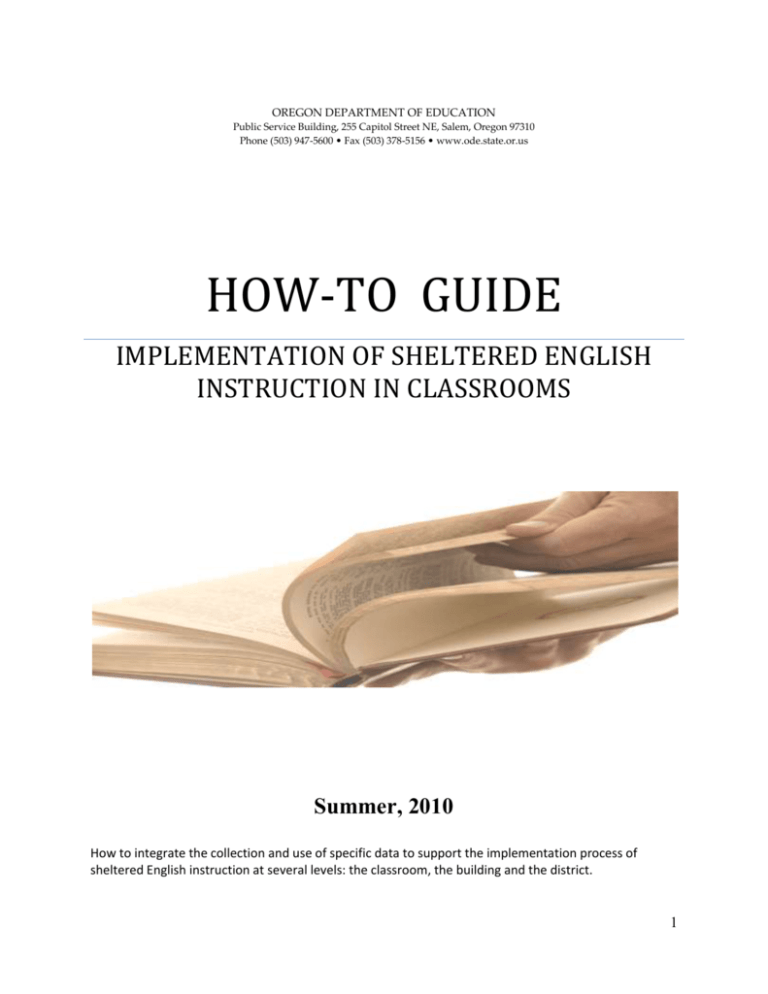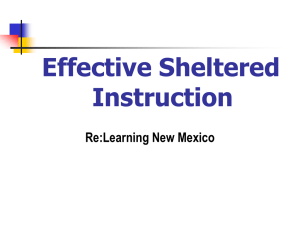How to guide implementation
advertisement

OREGON DEPARTMENT OF EDUCATION Public Service Building, 255 Capitol Street NE, Salem, Oregon 97310 Phone (503) 947-5600 • Fax (503) 378-5156 • www.ode.state.or.us HOW-TO GUIDE IMPLEMENTATION OF SHELTERED ENGLISH INSTRUCTION IN CLASSROOMS Summer, 2010 How to integrate the collection and use of specific data to support the implementation process of sheltered English instruction at several levels: the classroom, the building and the district. 1 Page Introduction 3 Critical Role of School Leaders 4-5 Six Possible Purposes for SEI Data-Collection 6-10 Self-Assessment & Progress Monitoring Tool Description 11 Collecting Data 12-13 Tabulating Data and Progress Monitoring 13-15 Appendix Note: Sheltered Instruction (i.e. SET, SI, SIOP, CALLA, SADAIE, GLAD) models are content teaching and learning approaches that should be implemented in conjunction with other services to address the specific linguistic needs of ELLs. Sheltered instructional approaches, in and of themselves, do not satisfy ORS 336.079: Special English courses for certain children. 2 A. INTRODUCTION The “How-to” Guide for Implementation of Sheltered English Instruction in Classrooms is a companion guide to the ‘Self-Assessment and Progress Monitoring for Sheltered English Instruction Classrooms’ tool (http://www.ode.state.or.us/search/page/?id=2532). It represents a collective effort from practitioners across the state of Oregon with expertise in the education of English language learners. This statewide advisory group convened periodically over twelve months, under the leadership of the ESL/Bilingual office at the Oregon Department of Education (ODE), to produce additional support materials and resources for districts and schools that endeavor to address the educational needs of English Language Learner (ELL) students. In August, 2005, the ODE published A Guide for Implementation of Content Support Programs for ELLs to promote shared understandings about sheltered instructional models and programs that serve English learners. It is our hope that these tools underscore the importance of using data to guide program decisions at all levels, and that they prove of high utility as they become an integral component of the sheltered English instruction program and school improvement efforts in schools serving ELLs. Note: Sheltered Instruction (i.e. SET, SI, SIOP, CALLA, SADAIE, GLAD) models are content teaching and learning approaches that should be implemented in conjunction with other services to address the specific linguistic needs of ELLs. Sheltered instructional approaches, in and of themselves, do not satisfy ORS 336.079: Special English courses for certain children. 3 B. The Critical Role of School Leaders Diligent efforts have been made to provide professional development opportunities for core content teachers in sheltered English instruction for several years and through a variety of delivery models. However, the actual transfer of such trainings into daily instructional practices continues to be elusive and challenging to quantify. The Self-Assessment and Progress Monitoring for Sheltered English Instruction (SEI) Classrooms is a data collection tool that quantifies specific teacher and student behaviors in the classroom over time to gauge the degree of SEI implementation and integration in the teaching and learning process. (The Big Four: A Simple and Powerful Framework to Dramatically Improve Instruction http://www.instructionalcoach.org/tools/Strategramsv21no4_BigFour.pdf) The critical role of school leaders in supporting implementation of sheltered English instruction strategies in the classroom ranges from encouraging classroom teachers to self-assess and reflect on their practices by collecting data using the Self Assessment Tool to training school or district teams in its proper use for peer observations, coaching, or instructional rounds (A Primer on Instructional Coaches by Jim Knight http://www.instructionalcoach.org/tools/Knight_PL2005-05.pdf) . School and district administrators set the tone and expectations for the transfer of sheltered instructional strategies to daily classroom practices. The SelfAssessment Tool provides administrators a means to gather detailed SEI data for determining professional development needs assessment, alignment with school improvement goals, and/or programmatic evaluation at the school or district level. The SEI tool bridges teacher training and implementation of the skills learned. The SEI data collection tool has been field tested in a variety of contexts to gather feedback from users. This How-To Guide is a companion to the Self-Assessment tool and was developed in response to recommendations from the state’s SEI advisory group. 4 The How-to Guide for Implementation of Sheltered English Instruction in Classrooms is organized in two parts: I) The Role of School Leaders in the Implementation of SEI in Classrooms; and II) The Self-Assessment and Progress Monitoring for Sheltered English Instruction Classrooms Tool Description. These resources are designed to integrate data collection for specific purposes: to inform practices in the classroom, school, and district level. Datadriven decisions are essential in supporting quality teaching and learning; (Data-Driven Instruction by Fen Fenton and Mark Murphy http://www.ascd.org/ascd-express/vol5/508-fenton.aspx) particularly datacollection processes designed to specifically address the linguistic and cognitive needs of English language learners. The growing K-12 ELL population and a persistent achievement gap between ELLs and non-ELL students continue to demand effective teaching and learning practices based on objective data. ELL student success is predicated on teacher expectations (Raising Expectations to Improve Student Learning by Jerry D. Bamburg http://www.ncrel.org/sdrs/areas/issues/educatrs/leadrshp/le0bam.htm); therefore, active involvement by school leaders and administrators in creating appropriate expectations seems essential to successful implementation. It is highly recommended that the Self-Assessment and Progress Monitoring for Sheltered English Instruction Classrooms (SEI) tool be used by district and site administrators prior to its deployment in schools to ensure common understandings of purpose, expectations, and use over time. The tool is not intended to be used in its entirety during a single observation event. Rather, it is recommended that special attention be given to individual sections and subcomponents monitoring progress of implementation over time as reflected by data. As seen in Figure No. 1, there are six possible critical applications for the use of SEI data collected through various observations of teaching and learning in sheltered instruction classrooms: 1) Self-evaluation; 2) Professional Growth Model; 3) Coaching; 4) Teacher Evaluation (Pre-Post); 5) Instructional rounds; and 6) Program Evaluation. 5 C. SHELTERED ENGLISH INSTRUCTION IN CLASSROOMS MULTIPLE PURPOSE DATA COLLECTION FOR THE IMPLEMENTATION OF SHELTERED ENGLISH INSTRUCTION IN CLASSROOMS I. SelfEvaluation II. Profession al Growth VI Program Evaluation V. Instructional Rounds: Walkthrougs Sheltered English Instructional Data Collection Tool III. Coaching IV Teaching and Learning Evaluation Figure No. 1. Six possible purposes for SEI data collection. 6 1. Self-Evaluation The Self-Assessment and Progress Monitoring for Sheltered English Instruction Classrooms tool is highly recommended for use by all teachers who have received training in sheltered instruction beyond the introductory step. While we often hear the phrase ‘good teaching is just good teaching’ and it benefits all students, we need to emphasize that acquiring a second language and the content delivered in that language requires addressing specific linguistic needs of English Language Learners. (Sheltered English Instruction http://www.alliance.brown.edu/tdl/tl-strategies/mcprinciples.shtml) ELLs face a double burdened in regular education classes: to acquire rigorous academic on-grade level content (a challenge for native English speakers) and to further their knowledge of the English language within the context of each core academic class. While good teaching is the basis for good instruction and learning in every regular education class, in a Sheltered English Instructional class, teaching strategies for comprehensible input that adjust to the English language proficiency levels of ELLs is indispensable. Sheltered instructional approaches are an enhancement to ‘good teaching.’ In fact, it is almost impossible to have a sheltered instruction classroom where such strategies are not precluded by general best practices. The SEI data collection tool allows classroom teachers to collect baseline information on their own practice and provide insights into areas of strengths and areas of growth. According to research, change in teacher practice does not always occur as a result of receiving training, a rational-empirical approach, based on the idea that because the content of the training is research-based all participants will simply transfer such training into daily instructional practice. (Five Paradoxes and Three Big Ideas for Instructional Coaches by Jim Knight http://www.instructionalcoach.org/tools/justread.pdf) We know all too well that that is not the case. Another unsuccessful approach to changing teacher practice is the top-down punitive approach of ‘thou-shall.’ We also understand the unproductive results of such approaches. The change in instructional practices must be grounded in teacher intrinsic motivation based on the belief that knowing what innovative strategies work and why and understanding what impact teachers want to have on learners will result in increased student achievement (A Conversation with Thomas R. Guskey – Evaluating Professional 7 Development http://www.hfrp.org/evaluation/the-evaluation-exchange/issuearchive/professional-development/a-conversation-with-thomas-r.-guskey). The SEI self-assessment tool provides teachers with the opportunity to examine the degree to which they have internalized newly learned strategies and the degree to which they see those integrated in their every lesson. Thus, SEI selfassessment data can provide an objective starting point to discuss continuous improvement in the teaching and learning process overall. 2. Professional Growth Model The application of data to guide professional development decisions for individuals or groups of individuals is a sure way to provide relevant training in areas where there is an evident need. The selection and development criteria for professional development requires a thoughtful process based on data collected with the SEI tool in a specific content area, grade level, school site, or even district wide. Patterns and trends in data collected over time shall point to strengths and weaknesses in the program and allow for targeted professional development design. The impact of teacher professional development can be measured as reflected in positive student learning outcomes, the highest level for evaluating professional development in Guskey’s professional evaluation rubric. 3. Coaching The SEI tool provides teachers and coaches with a consistent approach to collecting data on the teaching and learning process that offers factual information on sheltered English instruction classroom practices. Results of the data can be used to focus further professional development or coaching on areas that are identified as needing improvement. (Instructional Coaching by Lucy Steiner and Julie Kowal http://www.readingrockets.org/article/25980) 8 4. Teacher Evaluation District and school administrators who want to support school improvement efforts and realize the goals of increased academic success for culturally and linguistically diverse students, have the opportunity to fold the SEI tool into the teacher evaluation process. The SEI tool offers flexibility of selecting specific areas in a pre-observation and post-observation conference as a way to support improved teaching and learning. 5. Instructional Rounds – Walkthroughs The implementation of sheltered English instruction in classrooms in a school is dependent upon consistent best practices that are evident during instructional rounds, either by grade level, content area, or school. (Southern Metropolitan Region Round 2, Balnarring Primary School http://webcache.googleusercontent.com/search?q=cache:ClwUbutDd5cJ:instruc tionalrounds.wikispaces.com/file/view/SMR%2BRounds%2BBalnarring.ppt+instructi onal+rounds+in+education+powerpoint&cd=8&hl=en&ct=clnk&gl=us) (Research Report: Using Classroom Walkthroughs to Improve Instruction by Nancy Protheroe http://www.naesp.org/resources/2/Principal/2009/MA_p30.pdf) 6. Program Evaluation The use of sheltered English instruction data can provide the basis for an effective program evaluation system that uses evidence of teacher and student behaviors over time as factors that either hinder or promote student success rates. It is recommended that district and school leaders become adept users of the Self-Assessment and Progress Monitoring for Sheltered English Instruction Classrooms. The implementation of a comprehensive approach for using data on the implementation level of sheltered English instruction 9 teaching strategies that range from teacher self-assessment to program evaluation has significant ramifications for overall school improvement efforts. (An Introduction to a Program Evaluation for Classroom Teachers by Howard L. Fleischman and Laura Williams http://teacherpathfinder.org/School/Assess/assess.html#chap2) 10 SHELTERED ENGLISH INSTRUCTION CLASSROOMS TECHER BEHAVIORS: TEACHER BEHAVIORS: LESSON PREPARATION INSTRUCTION DELIVERY STUDENT BEHAVIORS: ACTIVE ENGAGEMENT & LEARNING SELF-ASSESSMENT AND PROGRESS MONITORING TOOL 11 D. THE SELF-ASSESSMENT PROGRESS MONITORING FOR SHELTERED ENGLISH INSTRUCTION: TOOL DESCRIPTION The Self-Assessment and Progress Monitoring for Sheltered English Instruction Classrooms (SEI) tool is designed to collect observation data in three major components of the teaching and learning process: 1) Teacher Behaviors - Lesson Preparation; 2) Teacher Behaviors – Instruction; and 3) Student Behaviors. Each of these components are described and grouped by observable behaviors in additional subcomponents as indicated below. The Teacher Behaviors, ‘Preparation’ and ‘Instruction,’ share the same subcomponents: Content Objectives; Language Objectives; Social-Affective; Lesson Delivery; and Assessment. The behavior descriptors align specifically to each of the major components, respectively. Student Behaviors’ descriptors are grouped by: Content Objectives, Language Objectives, Lesson and the Learners, and Social/Affective. Given that the transfer of sheltered English instruction training into daily instructional practices takes time and is not a sequential process, the SEI tool provides opportunities for base-line and progress monitoring data collection. This tool is designed to be used by/with a teacher who has received training in sheltered English instruction. Trained teachers can begin to quantify the practices that have been established in their classroom and those that need improving. Setting professional growth goals can be facilitated by the use of this SEI data. In addition, the SEI tool may be used as a collaborative effort in peer observations or in school wide improvement efforts. The tool is not intended to be used in its entirety during a single observation event. Rather, it is recommended that special attention is given to individual sections and subcomponents monitoring progress of implementation over time as reflected on evidence data. 12 E. COLLECTING DATA According to research teachers are the single most influential factor impacting student learning : “Effective teachers appear to be effective with students of all achievement levels, regardless of the level of heterogeneity in their classrooms” (Sanders, 1997,p. 63). Teachers who have been trained in sheltered English instruction can demonstrate the transfer and application of these skills in the classroom through behaviors in two areas: Evidence of Sheltered English Instruction A) Teacher Behaviors: Preparation B) Teacher Behaviors: Instruction Each of the above areas of teacher behaviors is comprised of the same five subcomponents as follows: a) b) c) d) e) Content objectives Language objectives Social/Affective Lesson Delivery: Instructional Strategies Assessment Evidence points can be gathered in each area by following the specific behavior descriptors that add up to a possible forty (40) points in each area. Evidence of SEI Student Behaviors According to cognitive theory and best practices, active student engagement precludes student learning; data gathering on specific student behaviors can provide valuable information related to effective sheltered instruction. The subcomponents for student behaviors that appear on the SEI tool are as follows: 13 a. b. c. d. Student can explain content objectives Student can explain language objectives Student demonstrates use of learning strategies Students demonstrate appropriate cognitive and social skills There are fourteen (14) evidence points for student behavior. The performance indicators allow tool users to identify student behaviors that have been established in the classroom based on evidence data and which student behaviors remain areas of focus. The tool is user friendly and can be utilized during pre-observation conferences to focus on collecting specific data. F. TABULATING DATA The Self-Assessment and Progress Monitoring for Sheltered English Instruction Classrooms (SEI) tool is designed to collect observation data in three major components of the teaching and learning process: 1) Teacher Behaviors - Lesson Preparation; 2) Teacher Behaviors – Instruction; and 3) Student Behaviors. Each of the components contains several subcomponents with observable behavior descriptors. The tool is not intended to be used as a summative evaluative tool which is used in its entirety during a single observation. Each component and subcomponent provides opportunities for specific targeted observations. The SEI tool is intended to assist practitioners with data collection for specific purposes and to monitor progress over time towards stated individual or collective goals to increase ELL linguistic and academic success. 1. Instructions A check mark should be noted for each of the behaviors that are evident during an observation, focusing perhaps on just one of the major areas. A ‘Summary Chart’ is provided as part of the tool for recording the number of evidence points earned during an observation. Progress monitoring towards full implementation is tracked by placing the number of evidence points earned during an observation on either Tier 1, 2, or 3 according to where the 14 earned points fall in relation to the range within each of the Tiers. See the example below. Summary Chart Points Earned: Total score from each of the three sections. Date of Visit/Self Assessment Teacher Behaviors—Lesson Preparation Teacher Behaviors—Lesson Preparation Points Earned Student Behaviors July 30, 2010 28/40 35/40 9/14 Tier Designation To place an observation on either Tier 1 (recently trained, demonstrates few observable behaviors), Tier 2 (demonstrates some observable behaviors), or Tier 3 (demonstrates nearly all observable behaviors), check the box that corresponds to the points earned under each section. Date of Visit Teacher Behaviors Lesson Preparation Tier 1=0-18 Tier 2=19-31 (points earned=28) Tier 3=32-40 Teacher Behaviors Instruction Tier 1=0-18 Tier 2=19-31 Tier 3=32-40 (points earned=35) Student Behaviors Tier 1=0-6 Tier 2=7-11 (points earned=9) Tier 3=12-14 15 Overall Rating For the overall rating, assign a point to each of the three tier designations as follows: Tier 1=1 point, Tier 2=2 points, Tier 3=3 points. Add the points and check the box that corresponds to the total number of points. Example: Teacher Behaviors Lesson Preparation=Tier 2=2 points, Teacher Behaviors Instruction=Tier 3=3 points, Student Behaviors=Tier 2=2 points. The total (2+3+2) is 7. A score of 7 indicates this teacher is at the top end of Tier Two. Tier One = 3-5 Tier Two = 6-7 Tier Three = 8-9 The goal for any sheltered English instruction classroom teacher should be Tier Three. Using the SEI tool either as an individual self-assessment or as a program assessment, allows for teachers, schools and districts to understand how they are progressing toward providing quality sheltered English instruction for ELLs and to identify both areas of strength and those needing improvement so students will receive quality sheltered English instruction that results in increased student achievement and success for ELLs. Progress monitoring towards full implementation of sheltered English instruction in classrooms requires ongoing observations and the use of data as an integral component of school improvement efforts and support for ELL student success. 16 Summarize information from graphics or notes names names names names Conduct research to glean information from multiple sources names Find details that support main ideas Express and defend point of view names names names names names Describe events, people, processes, procedures Offer creative solutions to issues, problems Level 5 Bridging Draw conclusions from oral information Apply information to new contexts names Produce drawings, phrases, short sentences, notes Sequence pictures, events, processes Level 4 Expanding Compare and contrast functions, relationships from oral information names Label objects, pictures, diagrams Identify facts and explicit messages names names Match icons and symbols to words Retell Stories or events names Ask WHQuestions Level 3 Developing Categorize or sequence oral information using pictures, objects names names Level 2 Beginning Match information form oral descriptions to objects, illustrations names Name objects, people, pictures names L I S T E N I N G S P E A K I N G R E A D I N G W R I T I N G Level 1 Entering Point to stated pictures, words, phrases names Can Do Descriptors







